
(Journelle, Fleur Du Mal, Araks, La Perla – see the Polyvore set)
When I first started making my own bras, I was dead set on having a “demi bra”. Mind you, I had no idea what that really meant but the bra in my imagination was something other than the patterns I had tried.
I’ve realized since that what I really wanted was a bra that felt “designed”, that had colors, textures and feelings–good design ideas. And for some reason the term demi conjured up prrretty.
I’m guessing that for some of us, a demi might anything that isn’t a full cup bra. “Demi” and even “balconette” are often used fairly loosely by retailers and designers which makes them even harder to pinpoint. All of the bras in the image at the top were ones that either a shop or designer listed as “demi”. And they all have different coverage and design shapes.
So today I want to refine these bra terms a bit more, the way I understand them–through their neckline shapes.
Full Cup
A true full cup bra is one that covers much of the top half of a breast.
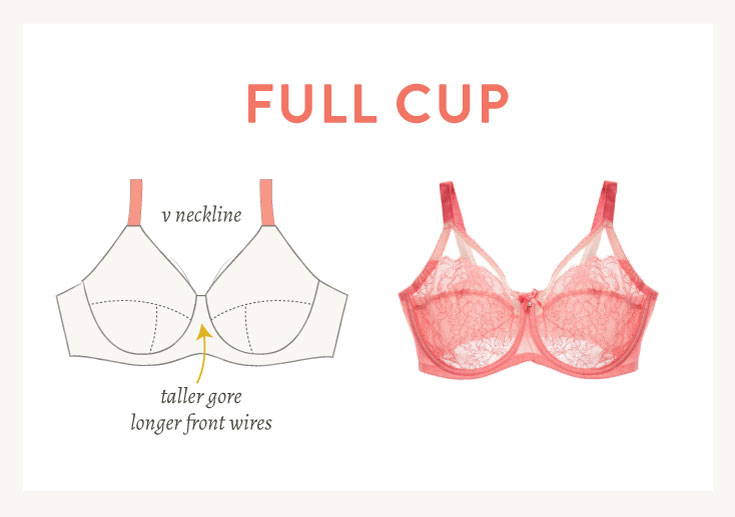
(photo: Retro full cup by Wacoal)
In these bras, you may notice that the upper part of the cup is higher–almost equal in height as the lower cup–and the straps are quite centered, starting higher up on the chest. (I really love the above example by Wacoal–goes to show you that a full cup doesn’t always mean beige and boring.)
Typical features of a full-cup bra:
- longer wires in front and sides
- high gore (bridge)
- wider band at side seam (as a result of longer wire)
- centered straps
You can take the same exact wires from a full cup bra and create styles with a lower neckline. This involves moving the strap position, or in the case of a strapless bra, removing the strap altogether.

In these styles the height of the center front stays the same as the full cup bra, but the neckline gets slightly more “squared” as the strap extension is lowered or removed.
The Half Cup
This is the style many associate with “demi”.
The word “demi” means “partial” or “half”. While most of the bras I’m illustrating in this post are technically “partial” in coverage, a half cup has a particular look. It is usually a low-cut cup with a squared neckline that encourages little bit of cleavage.
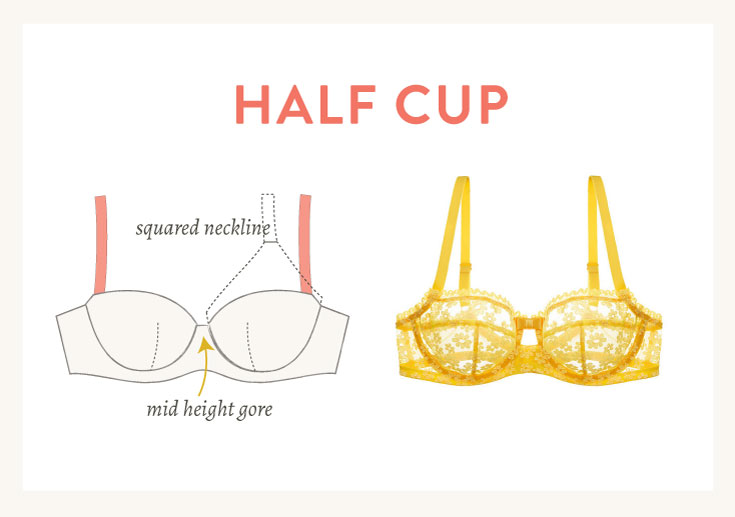
(photo: Melisande by Huit)
Some brands are really known for this style, such as Agent Provocateur, Simone Perele and Huit. Also take a look at half cups over at Bratabase (a bra review community) for examples in DD+ brands.
Typical features of half cup:
- Wires are often at equal heights in front and sides.
- Usually have a vertical dart or seam, or two vertical seams for larger cups. (The yellow Huit bra in my example is an exception with its horizontal seam.)
There’s a reason for the vertical seams, from a patternmaking perspective. Vertical seams make it easier to create a low and more open neckline while keeping the bottom of the cup a little bit more shallow, thus forcing the breasts upward.
I’ve made a couple of bras with a half cup style, one of which was this mint bra I made way back for the Bra-making Sew Along.
The Balconette
Here’s another term that’s used quite broadly–search for balconettes and you will find a range from very low-cut half cup styles to fuller-cup bras with a more revealing neckline.
I tend to think of a balconette as any bra that creates a sweetheart neckline.
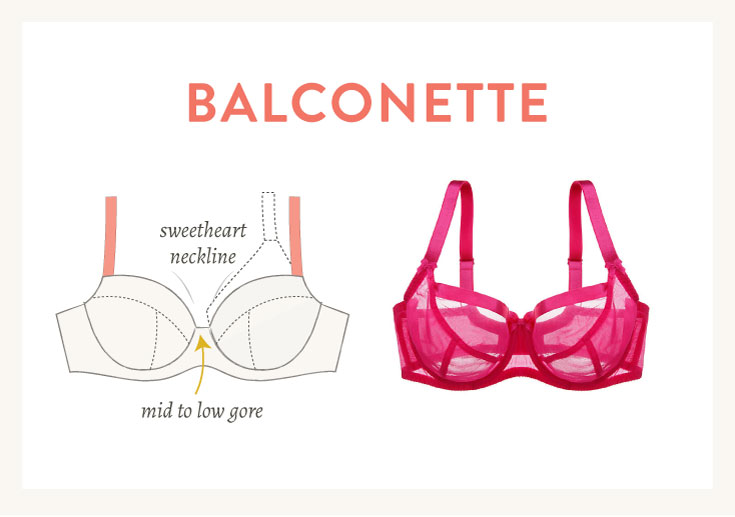
(photo: Paris by Miss Mandalay)
Features of a balconette:
- A lower bridge, and the front is lower than the sides.
- Often 3- or 4-piece cups with seams in opposing directions (the extra seaming allows for a more shapely, contoured neckline).
The Plunge
A plunge bra often has a “v-neck” appearance to it, just like a full cup bra, except of course that it plunges down between the breasts. Underwired plunge bras have dramatically shorter wires in the front.
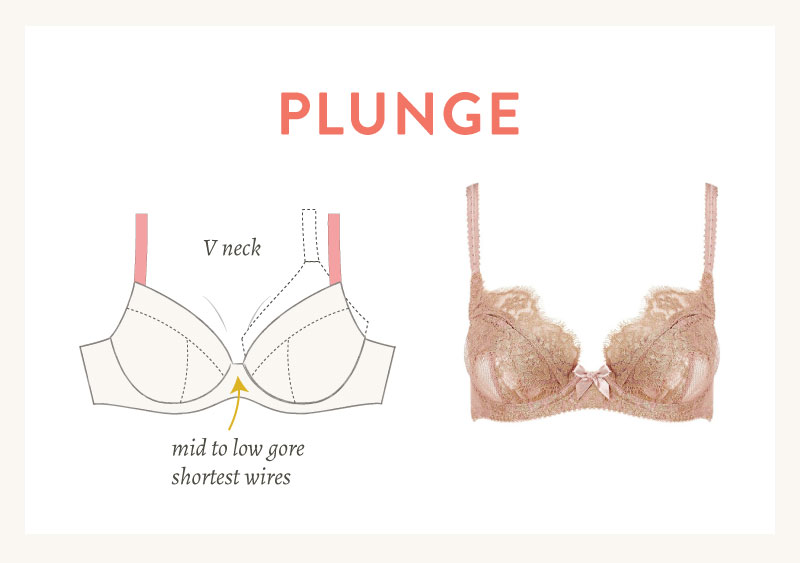
(photo: Iana by L’Agent)
Features of plunge bras:
- Lowest wires of all, often with a slight diagonal tilt in the front.
- Narrower bridge (gore), especially in push-up bras.
- In bralettes or soft cup bras, there is often no bridge (like the Watson, which is a plunging style neckline).
It’s all about the neckline
In this illustration I’ve laid all these styles on top of each other so you can see how their necklines compare:
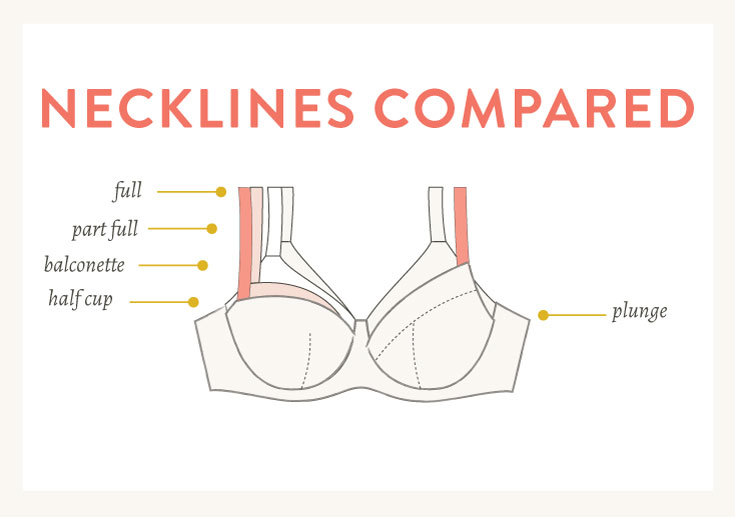
One thing to notice is that a bra’s neckline shape and coverage is really determined by two things: the wire height (if it’s a wired bra) and the strap position. Both of these are really easy to change in a bra pattern!
Shorten the front bridge and wire, and you start plunging the front neckline into more of a v-shape. Move the straps downward and outward, and you start creating more of a balconette or half cup. (For some ideas on how to do these things you might like my posts on cutting wires, cup alterations, or design alterations.)
I hope this analysis helps you understand bra styles a bit more and perhaps narrow in on why you like certain styles more than others!
For example, I often find myself creating plunge like bras because I like low wires (more comfortable on my sternum), I don’t need high wires but I like my straps a bit high and more centered.
What about you? Do you have a favorite style?
Would you like tips and inspiration in the craft of lingerie sewing? Sign up for my weekly eletter The Lingerie Maker.

This is an interesting approach to classifying bras. For what it’s worth, I’ve always understood the difference between balconette and demi-cup bras to be the breast shape they create. Balconettes create the appearance of breasts that are more projected and spherical, particularly on top. When taken to the extreme, I believe the look is termed “cakes-on-a-plate” (?) because the breasts appear supported from the bottom rather than suspended from the top. To enhance the effect, a balconette is usually cut relatively straight across (when viewed from the front) to show off the spherical shape they create. A demi-cup gives a less projected and less spherical shape, closer to a teardrop when viewed from the front. Does that jive with your experience, or is this impression perhaps driven by the style or marketing of a specific brand(s)?
Hi Caitlyn, That’s an interesting way to think of it! It’s near impossible to work around marketing terms since there’s not a lot of research about how these names evolved.
It seems to me that “demi” has become a catch all word for any bra that isn’t full coverage, at least in the lingerie industry. It’s used to describe all sorts of styles that don’t look anything alike to me. That’s why I broke it down into more specific shapes like half cup, balconette and plunge.
I tend to think of a half cup as rather low cut, with vertical seams and cut straight across the neckline. With that open neckline, those vertical seams definitely push upward, and in larger breasts this can totally give the “cakes on a plate” look! On the other hand, balconettes can do the same thing with the right shaping and narrow wires. The Cleo Marcie is what I think of as a classic balconette. It’s an example of that sweetheart neckline with the 3-part cup, and nearly everyone I know who wears it has quite a lifted spherical look in it.
Thanks for your thoughts!
I think of “balconette” in terms of word origin- “balconette” meaning the breasts are perched on a balcony. I associate this term with a horizontal neckline that props the breasts upward as if they are sitting on a flat shelf, with little or no strap extension. I think of Olivia Hussey’s costume in the balcony scene in Romeo and Juliet for even further word association 🙂
This is really helpful! I’ve been trying to make my own underwear, but have a very narrow sternum, so find it impossible to wear anything with a wide bridge. I tend to stick to plunge styles in RTW, but have been depressed at the lack of pretty patterns for making my own plunge bras. I love the Watson pattern, probably the most comfortable bras I own for lounging, but wanted a wired version. I didn’t realise you could alter the wire height of other patterns so easily, I was worried about altering the structure, as I wear an E or F cup, so thought I might lose support. What kind of cup design would you start with to re-draft a mid or high gore to a low gore plunge? It looks like the straps on a balconette or half cup would be too wide to give enough support to a lower centre, would a full or part full cup be better?
(Or perhaps I can persuade you to release a pattern for a wired-style Watson!)
Hi Liz! Both the strap position and the wire/gore height are super easy to alter. Those are two of the areas I would expect to adjust no matter what pattern I was using, since they will fit uniquely from person to person. You might like a cup with at least one vertical seam but I don’t think the cup design matters that much. A lot of women find bra straps too far apart and need to move them in so that’s a good adjustment to know how to do.
One quick suggestion… in larger cups, the lower the plunge the more the breasts want to splay apart. So it might take some experimenting to find that sweet spot where it feels good on your sternum but not so low that there’s no support in the inner part of your cup. I’d also try working with firm cup fabrics or foam linings to make sure you’re getting good support.
Hope that helps!
Thanks Amy, that’s really helpful. I have a couple of patterns from Merckwaerdigh but she tends to use stretch fabrics, so maybe this is where I’ve been going wrong. I do prefer a non-stretch or foam bra in RTW if I’m picking underwired styles, so perhaps I shouldn’t have been tempted by the pretty kits she does! I have Norma’s book, so perhaps I just need to be brave and start doing some playing about with patterns and wires!
Excited about the prospect of new patterns though! Can’t wait!
What a terrific post. While definitions are nice to have as are the history behind them, I often just select my pattern based on whether I like the appearance of the sketch. I’ve made a few bras, and the only ones that I like to wear (handmade) are my Watsons :). Like others, I would like to add a wire to the Watson for a wired plunge style. I think Anne of clothing engineer.com did a post a while back explaining how to do this. Unfortunately something happened with her blog and WordPress and she lost most of her stuff :(. I’ll figure it out at some point….that is unless you were to offer up a tutorial…wink, wink..hint hint.
Thanks again for what you do.
Genevieve of Sewabuttononyourunderware.com xo
Hi Genevieve, I’m totally with you on the appearance of the sketch!
I’m sorry to hear about Ann’s blog. My site has been hacked before and it’s a huge headache! Unfortunately, I don’t plan on doing a tutorial for a wired Watson, simply because I don’t want to mislead people, especially beginners to bra making, about its interchangeability with wired styles. Not that it’s impossible! There are a lot of pattern changes I would make to make it a better pattern for wires—the shape of the cradle, the bridge area, and a few tweaks to the cups. Simply inserting wires into the pattern as is isn’t good enough for me personally, and probably wouldn’t work very well for larger cups. But I’ve got some new bra patterns in the pipes and one of them will be “plunge” friendly!
Great round up! As Caitlyn stated above, I, too, feel that balconette bras – or at least the ones I wore over the years – and that were marketed as such, created less of a sweetheart shape but hat rather straight upper cup edges. Anyways, I love the style and I secretly hope, that your next pattern might become a demi or balconette bra?
Hi Annett, your secret hope is going to come true! I like hearing what everyone thinks about these terms. They’re definitely open for interpretation!
This is wildly helpful, even for a non-maker-only-bra-wearer like me. I like knowing how to name what I like in a bra. Thanks!